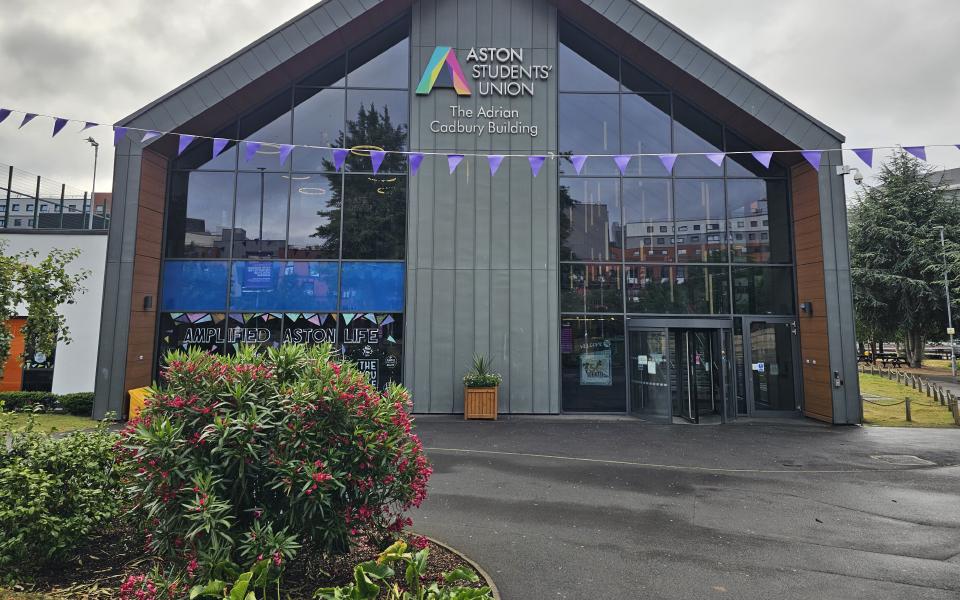International Sketchnote Camp 25
Reading time: 8 minutes
August 15, 2025
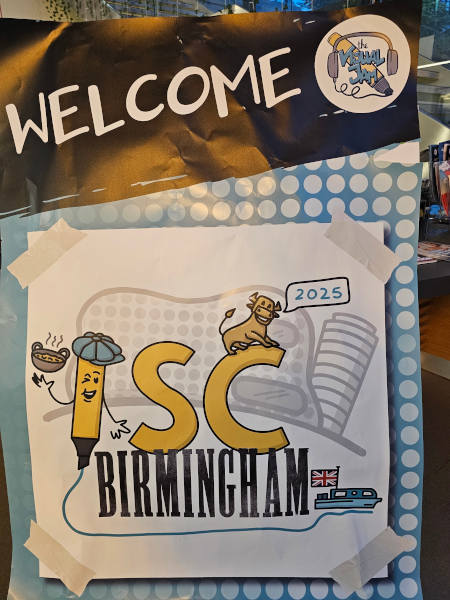
What’s it like attending an International Sketchnote Camp? From the perspective of a beginner enthusiast who has been to two - lively, visual, fun, whimsical. Expect lots of sketching, interesting conversations, new ideas, and new connections.
The majority of the folks seem to be graphic recording or graphic facilitation professionals. A few come from the education or training space, for which sketchnoting seems to have made some inroads, and the remainder come from various other spheres or life journeys. Beginners are welcome, and I found people to be open, warm, and generous.
The general flow over two and half days starts off with a Friday evening check-in and a social get-together. Saturday follows with a full day of keynotes. In the evening there is a fun social event. Sunday is barcamp day, which is what truly makes this conference special; things get “reversed”, with the attendees giving presentations.
Why attend?
Speaking to the beginner, yes, the conference offers a lot of value, exposing one to many talented individuals and many insightful ideas. My sketchnoting skills improved a notch, both from drawing and taking notes and also just being in that space and simply observing how other people tackled visual problems.
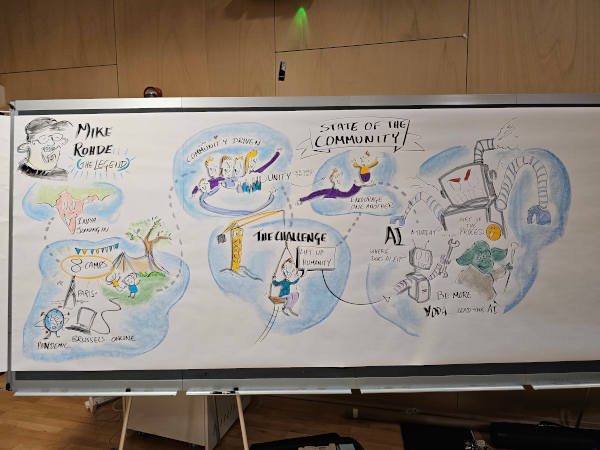
In ISC 24, I recall being exposed to many new ideas related to sketchnotes such as Bullet Journaling, Bikablo, books by Brandy Agerbeck, Neuland markers, etc. In ISC 25, it was more about going in depth and building on what I had practiced, which admittedly was not as many sketchnotes, lettering charts, icons, etc. as I had hoped in the 11 months between the two conferences. But it was still something. I was able to gather enough ideas to have new things to work on, and also deepen and develop connections with others in the community. The topic of AI also came up a number of times; the general theme, as I noted it, was that human creativity is as vital and important as ever.
ISC 25 also had a few vendor booths, including InkySketch, a local business who were selling books, accessories, and Neuland markers, and who took orders beforehand for pickup. I recall having some nice conversations with the owner Tom Russell, who was generous in his advice and offered a number of helpful tips and suggestions. I also picked up some markers and books!
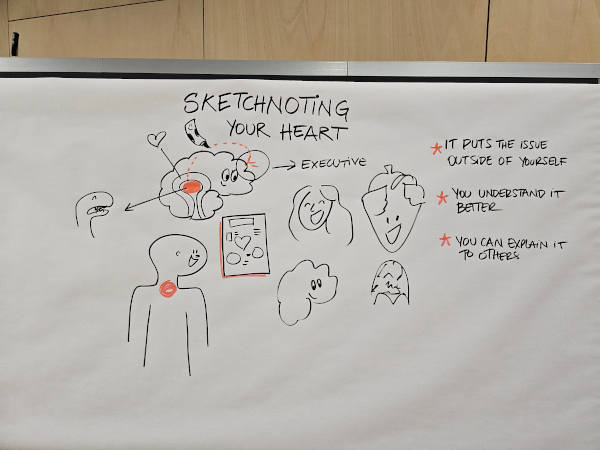
Now just stepping back a bit for some context, we can see that sketchnoting as a skill is quite accessible - just need a pen, paper, and some basic design principles to get started. Like any skill, it’s possible to go really deep. One can hone on particular areas such as lettering, handwriting, drawing people and objects, diagrams, icons, etc. and then go deeper with metaphors and trying to visualize abstract concepts. Over time, one can develop speed; I am not at that level, but I have seen what communicating fluently in visual language means. Listening (or related skills in summarizing texts or experiences) is another area to improve on, of being able to pick up just the right ideas worthy of capture.
Certainly for the beginner as well as intermediate practitioners, I really do think the conference offers a way to noticeably level up. Once one has read the books, seen some videos, listened to some podcasts (eg Sketchnote army podcast), and selected some sketchnotes for one’s portfolio, attending a conference can be a reasonable next step.
Neuland markers
Just a note on Neuland markers - Neuland is a German firm, and their markers and accessories are highly regarded in the sketchnote community. They truly are wonderful markers showcasing a “rich” sense of color whether used small-scale in a sketchnote or at chunkier sizes in a graphic recording visual. I feel they are uncommon in the US (at least I have not run into them in any art supply store) probably in part due to their high shipping costs, but now there is a US-based vendor - SketchCrafters - offering Neuland products with reasonable shipping costs (thanks to Tom for that tip!)
For small scale sketchnotes, I can speak highly of all three types of markers in their collection:
- FineOne Art - brush markers, good for filling in shapes
- FineOne Flex - flexible nib, so capable of some line variation
- FineOne Sketch - fine point markers
I can’t speak to the larger markers, as I currently don’t do graphic recording, but from what I observed at the conference, they seemed to perform well. Maybe it was the skill of the graphic recorder instead of the marker? Something I had once heard - is it Hendrix or his guitar?
Community
Something to be aware of - there is a robust sketchnoting community, but no central organization. There are key “players” with influence, I am pretty sure. Essentially, somebody in the community steps up and offers to host. They then have to arrange for a venue, catering, website, and all the innumerable other things that go along with this. This is all from what I heard, so I might be off with the details, but it’s something to keep in mind and reflect on.
Barcamp
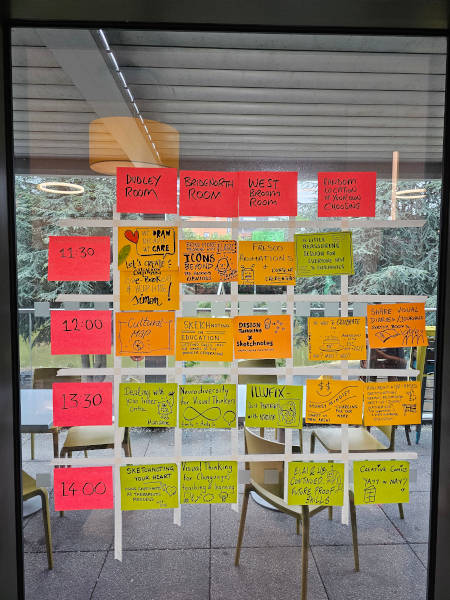
On paper, the barcamp idea sounds quirky and unique. Given how talented the attendees are (as noted, a number are professionals in this space), and simply the large domain of topics that can be covered - noting also how sketchnoting pairs well with psychology, design thinking, business, etc. - it actually makes a lot of sense. It also helps grow the community, as people can test out something that might one day develop into a future keynote session, and/or even something else like a blog post, book, course, etc. I really think other conferences should look into this idea of a barcamp.
As to how it works, there are about 4 or 5 time slots in the day, and at each time slot, about 4 - 6 sessions being concurrently offered in any of a number of areas: drawing faces, lettering, sketchnotes in education, drawing games, marketing, pricing, etc. There is a board with a grid indicating a time and room where people sign up and post what they will teach.
While I found each session to have something of value, for where I am in the journey, the ones on drawing and technique resonated with me. At the end of the day, each person truly will have had a customized experience winding through the schedule according to their interests and energy level.
One more piece of advice for beginners
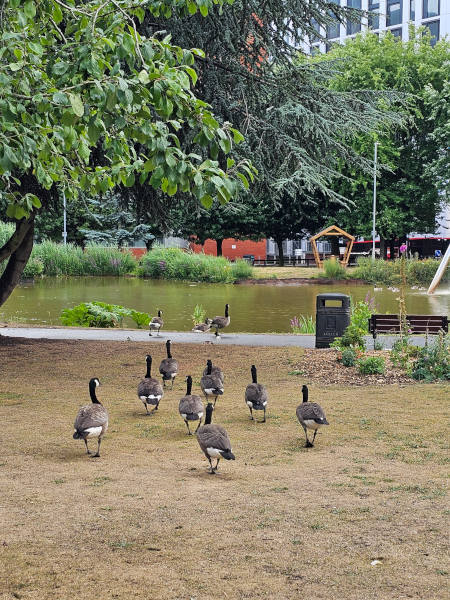
So yes, while beginners are welcome, if one has to make a trip to Europe (where the conference typically is held), book a hotel, cover food, transit, and other expenses, etc., my suggestion would be to come as a prepared beginner to get more out of the experience:
- Purchase and browse through Mike Rohde’s books - the Sketchnote Handbook and the Sketchnote Workbook
- These are books that can be read in one go, but which you can come back to again and learn something deeper
- There are other good books out there on sketchnoting, as well as videos worth checking out
- Do some sketchnotes - eg youtube video, podcast, book, travel notes, visual diary entry, or really whatever interests you
- Bonus
- Practice handwriting, particularly writing slowly
- Practice drawing simplified people, icons, and objects derived from a simple visual alphabet (square, triangle, circle, dot, line)
While the conference is reasonably priced, overall it’s an expense in time and money. But if you are seriously thinking about attending, you likely are a prepared beginner (at the minimum) and should not wait. It does sell out. And of course, if you do go, you could like me take a week off and make a trip out of it.
Some ISC 25 keynotes
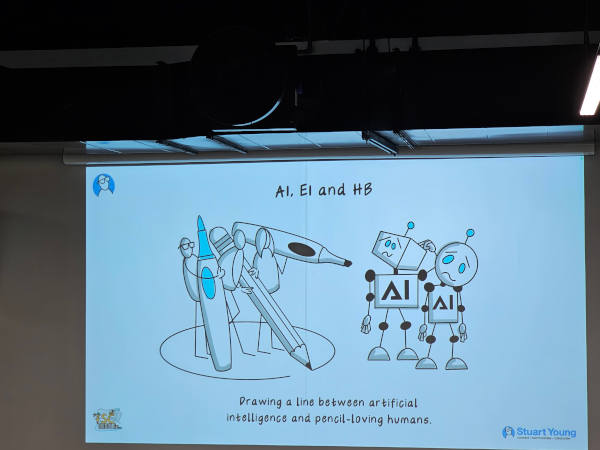
- AI, EI, and HB by Stuart Young.
- Fun class where Stuart reminds us of our value as humans.
- The 4 C’s - Communication, Connection, Cognition, and Complexity
- Being vulnerable is ok
- Flaws make us human
- Drawing people class by Andy Gray
- Fun drawing technique class
- Interesting point - if you draw realistically, people will notice mistakes
- Eleanor Beer keynote
- Powerful talk
- People connect with the “messy, honest human stuff”
- The Power of Creative Connections by Ben Walder and Olina Glindevi
- Lively conversation with a fun energy between the two
- Covers topics on how to work in a partnership, where things can get complicated
- JFDI time management - just do it style of getting things done
- Show and Grow Sketchnote critique
- The audience is broken into groups of four, where members of each group share sketchnotes that they would like to have critiqued
- I shared a book sketchnote on “City Planning” by Carl Abbott, and received helpful advice
- This session is particularly valuable for beginners, hopefully it will be a part of future ISC’s
- Cultivate Wonder by Alejo Porras
- What can I say, I really enjoy his talks and style
- I hope he posts some content, including sketchnotes, in Spanish (I did tell him this), as I am trying to learn it
- Takeaways - see where you stand relative to others, allow that realization to push yourself to improve, and then when you get good, make sure to contribute and give back
Extra tips
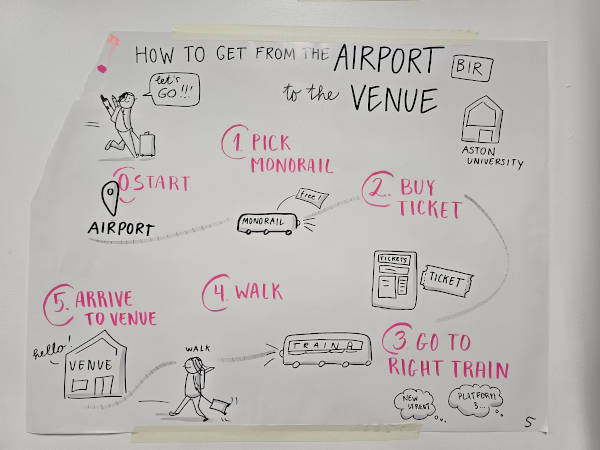
- Consider bringing a portfolio of your sketchnotes to show and ask for a critique. Paper sketchnotes can go in a presentation book (Blick Art Materials sells 8.5x11 and 9x12 notebooks), and digital sketchnotes could be exported to your phone or tablet.
- If you do digital sketchnoting, consider bringing your tablet as there may be sessions on visual apps such as Fresco, Procreate, Concepts, etc.
- Consider bringing a notebook
- My preference is an 5 x 8.25 inch Moleskine, which is easy to carry along and a nice size for travel sketchnotes.
- Also, ask for autographs. Sketchnoters give the best autographs!
- Be prepared to give an autograph too, at the very least on the big community board where people introduce themselves. So work on your visual signature!
